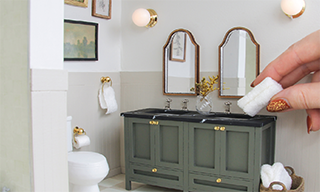
Materials, tools & supplies
#9308 The Buttercup Cottage
Dollhouse by Corona
#9205 3/8"W Strip Wood
#9146 1/4" Strip Wood
5 - 1/2" wood strips
2' x 2' 3/8" plywood sheet
1/8" x 3" Balsa Wood Sheet
#7045 Corner Moulding
#0018 Fieldstone Sheets
#0016 Rough Brick Sheet
<#7319 Flagtone Tile Sheet
#0039 Black Asphalt Shingle Sheets
#7122 Red Oak Random Flooring
#59020 Dollhouse Stucco
#2076 Mortar Mix
TEC Premixed Patch 'n Repair Adhesive
Grout for Ceramic Tile
CelluClay
#1249 Weldbond
#97008 Ultimate Craft Knife
#41001 Miter-Rite
Liquid Nails
Jig-saw
Iso Tip Minidrill
Dremel Wire Brush
1-1/2" Putty Knife
Fine Cellulose Sponge
Natural Sea Sponge
Craft Paint Brush
Disposable Foam Brush
Sand Paper or Emery Board
Scissors
2 - small pins
Wire Cutter
Wooden Modeling Tool or Orange Stick
#2217 Electrical Wire
#2202 Single Receptacle
#8065 9" Turntable
#1720 Wood Chips/Mulch
#1110 Door Pull
#964 Evergreen Bush
Birch Tree
Natural Bush Roots & Twigs
Red Rose Vine
Green Mix
Autumn Grass
Additional supplies
1/2 Pint Minwax Stain
Oil based Stain
Craft Paint
Raw Umber
Coffee Bean
Country Tan
Dark Grey"
Satin Black
Brown
White
Gray
Kilz Oil-based Sealer
Model Masters' "Panzer Grey" Spray Paint
Krylon's "Make It Suede" Spray Paint
60# Card Stock
Plain Paper
Inkjet Transparency Film
Rigid Foam Insulation Sheet
Black Fine-Tipped Pen
Bowl of Water
Clothes Pins
Computer with Color Ink Jet Printer
Glue Gun
Masking Tape
Paper Towels
Soft Pencil
Toothpicks
Click here for a downloadable instructions.
Kit "Bashing"
To transform any dollhouse kit into a Tudor-style house, it needs to have the appearance of being a post and beam, wattle, and daub structure. The framework of small Tudor houses was built with thick oak posts and braced with oak beams. Between the posts and beams, they used "wattles" which were loose screens woven from thin, split lengths of oak between upright staves. Then, they would plaster both sides of the wattles with "daub." Daub is basically mud -- a mixture of clay, straw, and animal dung. They also added copious amounts of lime as a disinfectant. Throughout the British Isles, daubed houses have different colors depending on the color of the local soil and the amount of lime that was added.
I "bashed" the Buttercup kit; meaning I altered it to serve my purpose. As it is, the Buttercup makes a lovely little shop because of all of its windows. Tudor houses, without central heating, didn't have very many windows and I wanted at least one solid wall where I could put a Welsh Cupboard. I also wanted one wall to be dominated by a large fireplace. So on the left side of the house, where it would be built into the rocky outcrop, I didn't punch out the front window. On the left side wall, I used a jig-saw to cut out an opening for the fireplace. On the front entry wall, I didn't punch out the windows on either side of the door. Above the door, I cut out the brace so that instead of a door and a window above, I had a taller, arched doorway. I also cut out the brace on the window opening on the right sidewall.
Posts & Beams
I began work on the focal walls of the house -- the front entry wall and the window seat wall -- before assembling the whole structure. Because of the smaller size of the Buttercup, I simulated the posts and beams out of 1/8" x 3/8" strip wood instead of using 1/2" which would be more historically accurate. I used 3/8" corner moulding to wrap around the corners and look like posts. I used many of the trim pieces provided with the kit. But, using a craft knife, I sliced V-grooves where I wanted joins in the wood so they look like they are built out of separate pieces of wood instead of being one die-cut piece. This is a good technique to use on any die-cut house and adds depth and realism to the pieces.
Basswood strip wood is very smooth which is normally a good thing but I wanted the posts and beams to look rough-hewn. To "rough up" the strip wood, I used a Dremel stainless steel wire brush attachment in a variable speed minidrill. I set the drill on a medium speed and simply moved the wire brush back and forth along the length of the strip of wood and then wiped off the sawdust. The luan plywood trim pieces from the kit are rough enough and don't need any distressing.
I used the "Colonial Maple" stain. Because the wood strips were roughed up, the stain was absorbed in different strengths and created a very realistic effect. I applied the stain with a disposable foam brush and immediately wiped off the excess with a paper towel.
To cut the wood strips, I used a Dobson Miter-Rite and made some of the angle cuts with a craft knife. One of the many enjoyable aspects of this project is that everything doesn't have to be perfect. (Tudor houses weren't built by professionals.) Instead of cutting precise joins for my posts and beams, I did many of the angles free-hand. I glued them down with Weldbond. Trimming and altering die-cut pieces is easy to do with a craft knife -- just remember to replace your blade often so it is always sharp.
Making the Door
To make the door, I glued, side by side, five 1/2" wood strips with one 1/4" strip, all 1/8" thick and 7" long (available at craft and hobby stores). I then laid the front entry wall on top of them and used the door opening as a template to cut a round top onto the plank door. I roughed up the wood, front and back, with the wire wheel. Then glued three 1/2" cr


